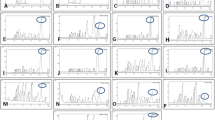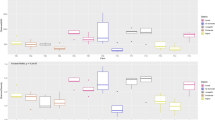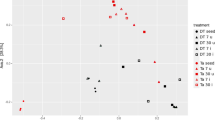Abstract
Endophytic microorganisms play a significant role in plants response to beneficial organisms and pathogens. In the current study, endophytic microorganisms from Zingiber officinale were screened for in vitro inhibition against Pythium myriotylum. From this, Burkholderia vietnamiensis ZoB74 was selected as an organism with remarkable antifungal effect. Further, the study focussed on analysis of in vivo changes in endophytic bacterial community of Z. officinale in presence of selected organisms and the pathogen P. myriotylum by PCR-DGGE. 16S rDNA sequencing of bacterial community after DGGE has resulted in the identification of a group of uncultured bacteria as the predominant microbial community of rhizome under various conditions of treatment. High frequency dominance of these endophytic bacteria suggests their role in disease resistance to soft rot in ginger. This also revealed the variation of endophytic microbiome of Z. officinale under biotic stress. Hence the study provides molecular insight into uncultured microbiome and its stress-inducible variation in ginger rhizome.

Similar content being viewed by others
References
Abreu-Tarazi MF, Navarrete AA, Andreote FD, Almeida CV, Tsai SM, Almeida M (2010) Endophytic bacteria in long-term in vitro cultivated “axenic” pineapple microplants revealed by PCR–DGGE. World J Microbiol Biotechnol 26(3):555–560. https://doi.org/10.1007/s11274-009-0191-3
Araujo WL, Marcon J, Maccheroni W Jr, Van Elsas JD, Van Vuurde JW, Azevedo JL (2002) Diversity of endophytic bacterial populations and their interaction with Xylella fastidiosa in citrus plants. Appl Environ Microbiol 68(10):4906–4914
Chakravorty S, Helb D, Burday M, Connell N, Alland D (2007) A detailed analysis of 16S ribosomal RNA gene segments for the diagnosis of pathogenic bacteria. J Microbiol Methods 69(2):330–339. https://doi.org/10.1016/j.mimet.2007.02.005
Chong TM, Yin WF, Mondy S, Grandclement C, Dessaux Y, Chan KG (2012) Heavy-metal resistance of a France vineyard soil bacterium, Pseudomonas mendocina strain S5.2, revealed by whole-genome sequencing. J Bacteriol 194(22):6366. https://doi.org/10.1128/JB.01702-12
Claesson MJ, Wang Q, O’Sullivan O, Greene-Diniz R, Cole JR, Ross RP, O’Toole PW (2010) Comparison of two next-generation sequencing technologies for resolving highly complex microbiota composition using tandem variable 16S rRNA gene regions. Nucleic Acids Res 38(22):e200. https://doi.org/10.1093/nar/gkq873
de Melo Pereira GV, Magalhães KT, Lorenzetii ER, Souza TP, Schwan RF (2012) A multiphasic approach for the identification of endophytic bacterial in strawberry fruit and their potential for plant growth promotion. Microb Ecol 63(2):405–417. https://doi.org/10.1007/s00248-011-9919-3
Denny TP (2006) Plant growth promoting rhizobacteria. In: Plant associated bacteria. Springer, Dordrecht
Gagne-Bourgue F, Aliferis KA, Seguin P, Rani M, Samson R, Jabaji S (2013) Isolation and characterization of indigenous endophytic bacteria associated with leaves of switchgrass (Panicum virgatum L.) cultivars. J Appl Microbiol 114(3):836–853. https://doi.org/10.1111/jam.12088
Garbeva P, van Overbeek LS, van Vuurde JWL, van Elsas JD (2001) Analysis of endophytic bacterial communities of potato by plating and denaturing gradient gel electrophoresis (DGGE) of 16S rDNA based PCR fragments. Microb Ecol 41(4):369–383. https://doi.org/10.1007/s002480000096
Heinaru E, Truu J, Stottmeister U, Heinaru A (2000) Three types of phenol and p-cresol catabolism in phenol- and p-cresol-degrading bacteria isolated from river water continuously polluted with phenolic compounds. FEMS Microbiol Ecol 31(3):195–205. https://doi.org/10.1111/j.1574-6941.2000.tb00684.x
Jasim B, Rohini S, Anisha C, Jimtha C, Radhakrishnan EK (2013) Antifungal and plant growth promoting properties of endophytic Pseudomonas aeruginosa from Zingiber officinale. J Pure Appl Microbiol 7(2):1–7
Jin H, Yang XY, Yan ZQ, Liu Q, Li XZ, Chen JX, Zhang DH, Zeng LM, Qin B (2014) Characterization of rhizosphere and endophytic bacterial communities from leaves, stems and roots of medicinal Stellera chamaejasme L. Syst Appl Microbiol 37(5):376–385. https://doi.org/10.1016/j.syapm.2014.05.001
Kuklinsky-Sobral J, Araújo WL, Mendes R, Pizzirani-Kleiner AA, Azevedo JL (2005) Isolation and characterization of endophytic bacteria from soybean (Glycine max) grown in soil treated with glyphosate herbicide. Plant Soil 273(1–2):91–99. https://doi.org/10.1007/s11104-004-6894-1
Lian J, Wang Z, Zhou S (2008) Response of endophytic bacterial communities in banana tissue culture plantlets to Fusarium wilt pathogen infection. J Gen Appl Microbiol 54(2):83–92
Ma B, Lv X, Warren A, Gong J (2013) Shifts in diversity and community structure of endophytic bacteria and archaea across root, stem and leaf tissues in the common reed, Phragmites australis, along a salinity gradient in a marine tidal wetland of northern China. Antonie Van Leeuwenhoek 104(5):759–768. https://doi.org/10.1007/s10482-013-9984-3
Meena KK, Mesapogu S, Kumar M, Yandigeri MS, Singh G, Saxena AK (2009) Co-inoculation of the endophytic fungus Piriformospora indica with the phosphate-solubilising bacterium Pseudomonas striata affects population dynamics and plant growth in chickpea. Biol Fertil Soils 46(2):169–174. https://doi.org/10.1007/s00374-009-0421-8
Morales SE, Cosart TF, Johnson JV, Holben WE (2009) Extensive phylogenetic analysis of a soil bacterial community illustrates extreme taxon evenness and the effects of amplicon length, degree of coverage, and DNA fractionation on classification and ecological parameters. Appl Environ Microbiol 75(3):668–675. https://doi.org/10.1128/AEM.01757-08
de Melo Pereira GV et al (2012) A multiphasic approach for the identification of endophytic bacterial in strawberry fruit and their potential for plant growth promotion. Microbiol Ecol 63:405–417. https://doi.org/10.1007/s00248-011-9919-3
Pei C, Mi C, Sun L et al (2017) Diversity of endophytic bacteria of Dendrobium officinale based on culture-dependent and culture-independent methods. Biotechnol Biotechnol Equip. https://doi.org/10.1080/13102818.2016.1254067
Peiffer JA, Spor A, Koren O, Jin Z, Tringe SG, Dangl JL, Buckler ES, Ley RE (2013) Diversity and heritability of the maize rhizosphere microbiome under field conditions. Proc Natl Acad Sci USA 110(16):6548–6553. https://doi.org/10.1073/pnas.1302837110
Peñuelas J, Rico L, Ogaya R, Jump AS, Terradas J (2012) Summer season and long-term drought increase the richness of bacteria and fungi in the foliar phyllosphere of Quercus ilex in a mixed Mediterranean forest. Plant Biol 14(4):565–575. https://doi.org/10.1111/j.1438-8677.2011.00532.x
Puerari C, Magalhães-guedes KT, Schwan RF (2015) Bacaba beverage produced by Umutina Brazilian Amerindians: microbiological and chemical characterization. Braz J Microbiol 1216:1207–1216
Rohini S, Aswani R, Kannan M, Sylas VP, Radhakrishnan EK (2017) Culturable endophytic bacteria of ginger rhizome and their remarkable multi-trait plant growth-promoting features. Curr Microbiol. https://doi.org/10.1007/s00284-017-1410-z
Sabu R, Radhakrishnan EK (2016) Bioprospecting of endophytic bacteria from Zingiber officinale with antibacterial activities. Int J Curr Microbiol Appl Sci 5(9):462–467. https://doi.org/10.20546/ijcmas.2016.509.050
Sabu R, Soumya KR, Radhakrishnan EK (2017) Endophytic Nocardiopsis sp. from Zingiber officinale with both antiphytopathogenic mechanisms and antibiofilm activity against clinical isolates. 3 Biotech 7(2):115. https://doi.org/10.1007/s13205-017-0735-4
Trivedi P, Duan Y, Wang N (2010) Huanglongbing, a systemic disease, restructures the bacterial community associated with citrus roots. Appl Environ Microbiol 76(11):3427–3436. https://doi.org/10.1128/AEM.02901-09
Wang J, Lu C, Min D, Wang Z, Ma X (2007) A mutation in the 5′ untranslated region of the BRCA1 gene in sporadic breast cancer causes downregulation of translation efficiency. J Int Med Res 35(4):564–573
Ward DM, Weller R, Bateson MM (1990) 16S rRNA sequences reveal numerous uncultured microorganisms in a natural community. Nature 345(6270):63–65. https://doi.org/10.1038/345063a0
Xiong XQ, Liao HD, Ma JS, Liu XM, Zhang LY, Shi XW, Yang XL, Lu XN, Zhu YH (2013) Isolation of a rice endophytic bacterium, Pantoea sp. Sd-1, with ligninolytic activity and characterization of its rice straw degradation ability. Lett Appl Microbiol 58(2):123–129. https://doi.org/10.1111/lam.12163
Yang B, Wang Y, Qian P-Y (2016) Sensitivity and correlation of hypervariable regions in 16S rRNA genes in phylogenetic analysis. BMC Bioinform 17:135. https://doi.org/10.1186/s12859-016-0992-y
Yu J, Zhou X-F, Yang S-J, Liu W-H, Hu X-F (2013) Design and application of specific 16S rDNA-targeted primers for assessing endophytic diversity in Dendrobium officinale using nested PCR-DGGE. Appl Microbiol Biotechnol 97(22):9825–9836. https://doi.org/10.1007/s00253-013-5294-y
Acknowledgements
This work was funded by the Kerala State Council for Science, Technology and Environment for the KSCSTE—Fellowship (Council Order No. 010-40/FSHP/2010CSTE), and Kerala State Council for Science, Technology and Environment—Science Research Scheme (274/2015, KSCSTE Dated 6 July 2015).
Author information
Authors and Affiliations
Corresponding author
Ethics declarations
Conflict of interest
The authors declare that they have no conflict of interest.
Electronic Supplementary material
Below is the link to the electronic supplementary material.
Rights and permissions
About this article
Cite this article
Sabu, R., Aswani, R., Prabhakaran, P. et al. Differential Modulation of Endophytic Microbiome of Ginger in the Presence of Beneficial Organisms, Pathogens and Both as Identified by DGGE Analysis. Curr Microbiol 75, 1033–1037 (2018). https://doi.org/10.1007/s00284-018-1485-1
Received:
Accepted:
Published:
Issue Date:
DOI: https://doi.org/10.1007/s00284-018-1485-1




